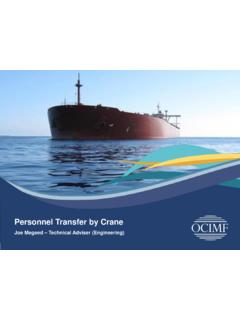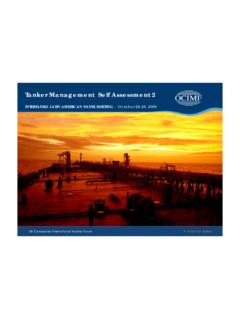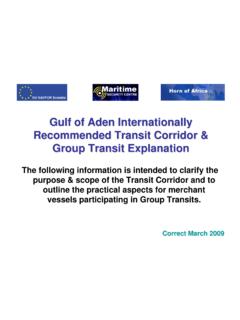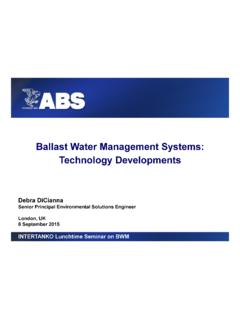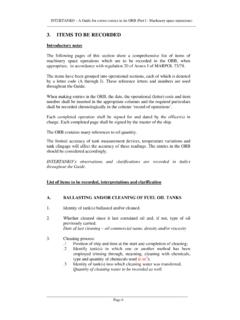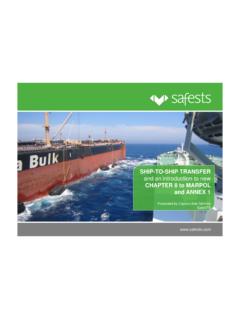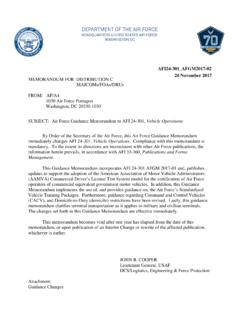Transcription of Guidelines on Capabilities of Emergency Response …
1 Copyright OCIMF 2013 Oil Companies International Marine Forum Guidelines on Capabilities of Emergency Response Services February 2013 The OCIMF mission is to be the foremost authority on the safe and environmentally responsible operation of oil tankers, terminals and offshore support vessels, promoting continuous improvement in standards of design and on Capabilities of Emergency Response Services 2 Copyright OCIMF 2013 Issued by the Oil Companies International Marine Forum 29 Queen Anne s Gate London SW1H 9BU United Kingdom Tel +44 (0)20 7654 1200 FAX +44 (0)20 7654 1205 E-Mail Web Oil Companies International Marine Forum, Bermuda The Oil Companies International Marine Forum (OCIMF) is a voluntary association of oil companies having an interest in the shipment and terminalling of crude oil and oil products.
2 OCIMF is organised to represent its membership before, and consult with, the International Maritime Organization (IMO) and other government bodies on matters relating to the shipment and terminalling of crude oil and oil products, including marine pollution and safety. Terms of Use While the advice given in this information paper ( Paper ) has been developed using the best information currently available, it is intended purely as guidance to be used at the user s own risk. No responsibility is accepted by the Oil Companies International Marine Forum ( OCIMF ), the membership of OCIMF or by any person, firm, corporation or organization (who or which has been in any way concerned with the furnishing of information or data, the compilation or any translation, publishing, supply or sale of the Paper)
3 For the accuracy of any information or advice given in the Paper or any omission from the Paper or for any consequence whatsoever resulting directly or indirectly from compliance with, or adoption of or reliance on guidance contained in the Paper even if caused by a failure to exercise reasonable care. Guidelines on Capabilities of Emergency Response Services 3 Copyright OCIMF 2013 Contents 1 Introduction 4 2 Organisation 4 Appropriate location and equipment 4 Access to appropriate vessel data 4 Business continuity 5 Emergency team capability 5 Response times 5 Service Provider resources 5 Communication language 5 Level of assistance 5 Demobilization 5 Reporting 6 Additional expertise 6 Environmental data 6 Vessel loaded condition 6 3 Competency 6 Initial training 6 Training and exercises 6 Simulation drills 7 4 Stability Assessment 7 Calculation models and
4 Software 7 Standard casualty information exchange 7 5 Structural Strength Assessment 7 First tier: Immediate structural strength analysis 7 Initial longitudinal strength calculation 7 Midship 2-D section 8 Additional 2-D sections 8 Second tier: Post initial Response detailed structural analysis 8 3-D beam model analysis 8 3-D finite elements analysis 8 Annex 1: Recommended Basic document 9 Annex 2: International Regulations 10 Guidelines on Capabilities of Emergency Response Services 4 Copyright OCIMF 2013 1 Introduction According to current regulations oil tankers must have prompt access to computerized, shore-based damage stability and residual structural strength calculation programs.
5 Whilst other vessel types are not currently regulated, the principles outlined in this paper may apply to other vessel types such as gas and chemical tankers. The means by which this access is arranged is not described in the legislation. The scope of services to be rendered is only described briefly and too vaguely to enforce a performance standard. Capability of the service provider is not addressed in the legislation. Classification Societies and other entities offer such services to the ship operator, but variations in the level and scope of service provided have been noted. Operators may even elect to provide this service internally without the assistance of external service providers.
6 Emergency Response Services (ERS) are rarely used, and as such may not attract appropriate priority of emphasis in vessel management. Merely having a service agreement in place does not ensure that, when needed, the quality of service provided meets the need. Recognising the potential hazards associated with the lack of consistency in the provision and utilisation of ERS, the OCIMF Marine Technical Sub-committee was tasked to form a Working Group to review current systems and practices in the industry, and to make any necessary recommendations for improvement. The objective of these Guidelines is to clarify and recommend the minimum scope of ERS provision, and to give advice on suggested minimum requirements of competency and capability of ERS service providers.
7 2 Organisation To ensure a prompt and reliable service the following minimum services are recommended: Appropriate location and equipment A dedicated ERS room (or suite of rooms) should be available for use by the ERS team at any time. The room should be equipped with: Appropriate dedicated equipment to enable the ERS team to communicate with the vessel staff and shore management, by voice and document (multiple telephones, conference phone, multiple LAN and internet connections, and at least one fax machine) Computers powered by secure power supplies with appropriate structural and stability analysis software pre-installed Means to display information to all team members (shared computer database or white-boards) TV and video recording capability.
8 Providers may wish to consider the ability to receive digital pictures or video direct from the casualty via internet. Access to appropriate vessel data Vessel data should be made available by the vessel operator on inception of service provision, (and not when the casualty occurs), so that the appropriate computerized models of vessel can be prepared by the ERS provider. This data and associated models can be in the form of paper and/or electronic files (see Annex 1 for the minimum documentation recommended). The service agreement should ensure that the data (drawings and records) are kept up to date. Access to the data should be controlled. Appropriate means of duplication should be used to ensure single point failure does not deny access to data (eg duplicate server records, archive copies of paper records).
9 The service agreement should include the following; Description of the ERS Emergency contact details of the ERS Expected standard Response times of the ERS Ship-specific Casualty Information Exchange sheets Guidelines on Capabilities of Emergency Response Services 5 Copyright OCIMF 2013 Requirement to update records and vessel data at ERS Requirement to provide the ERS with cargo loading status Drill scope and schedule requirements (One drill annually as a minimum) Incorporation of or reference to the ERS within the Safety Management System (SMS) will ensure that vessel staff are familiar with ERS procedures, as a result of training, exercises, and internal auditing conducted as part of the vessel operator s compliance with International Safety Management Code under SOLAS.
10 Business continuity Service providers should ensure that continuity of service can be maintained when access to buildings, rooms, data or services is interrupted. This should involve establishment of a business continuity plan, with provision for access to alternate locations, methods of data access and communication whenever deemed necessary. Emergency team capability The service provider should ensure that the Emergency team is appropriately resourced and should be competent to assess the full range of stability and structural strength calculations required in the event of any Emergency . The provider should establish a single point of contact for all communications.
